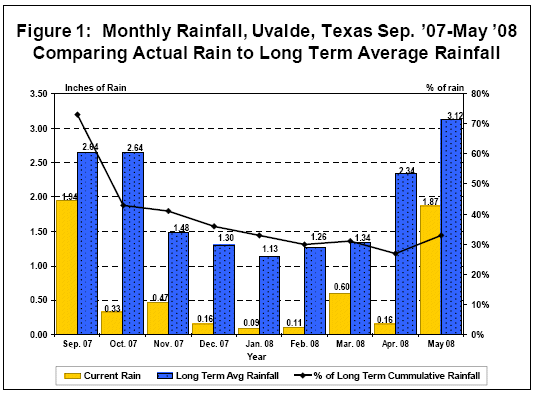AG-ECO NEWS
Vol. 24, Issue 17, June 11, 2008 – PDF version
Jose G. Peña
Texas AgriLife Extension Economist-Management
While Near Record High Commodity Prices Indicate A Potential For Record High Net Farm Income; The Continuing Drought In Southwest Texas Will Make 2008 A Difficult Year For Agriculture
While USDA’s latest forecast of net U.S. farm income for 2008 is at a record $92.3 billion, the continuing severe drought in southwest Texas and in a large portion of Texas indicates that 2008 will be a difficult year for agriculture in a large part of Texas. And, forecasts for rain do not appear optimistic. So, it becomes particularly important to initiate drought management plans.
As measured in Uvalde, the southwest Texas region, which probably reflects the relative rainfall condition for a large portion of Texas, entered into drought conditions (75% of average annual rainfall) in September 2007 and has remained in severe drought conditions since then. The last 9 month period since September 1, 2007 is the driest period on record. May ’08 ended with cumulative rainfall at about 33 percent of the long term cumulative rainfall since September 1. (See Figure 1). High, dry southerly winds are aggravating the drought. 
While most of Texas received excellent above average rainfall during spring/summer 2007, the current drought comes closely behind the severe drought of 2005-’06.
La Niña
Unfortunately, the short-to-mid-term outlook for rain appears dim. Weather forecasts by the National Weather Service indicate a continuation of the ongoing La Niña phenomena through the next two to three months. El Niño and La Niña are terms referring to large-scale changes in sea-surface temperature across the eastern tropical Pacific. La Niña is the opposite of El Niño. El Niño features a strong jet stream and storm track across the southern part of the U.S, and less storminess and milder-than-average conditions across the North compared to La Niña, which features a very wave-like jet stream flow over the U.S. and Canada, with colder and stormier than average conditions across the North, and warmer and less stormy conditions across the South. This means that La Niña brings wetter than normal conditions across the Pacific Northwest and dryer and warmer than normal conditions across much of the southern tier. While La Niña is bringing too much rain and causing flooding in the North Central region of the U.S., including the corn belt, it is bringing a severe drought to the southern tier.
Potential for Higher Prices
Too much rain in the corn belt has delayed planting and crop progress. As of last Monday (6.9.08), U.S. corn planting was about five percent behind a five-year average and only 89 percent of crop had emerged compared to five-year average of 95 percent. An estimate of six percent of the U.S. corn crop behind schedule appears insignificant, but it accounts for about 5.2 million acres of corn. Add a 60 percent good-to-excellent corn crop condition rating compared to a five year average of 77 percent at this time, and you have a situation which could reduce corn production significantly and push prices even higher.
In the mean time, a substantial amount of corn and sorghum in Texas under dryland conditions is doing poorly or will not make a crop. Reduced production may not allow farmers to capture these record high prices. Increased costs of corn production under irrigation may off-set potential profits.
Pastures and Ranges
Forage is in short supply. Even with minimum livestock stocking rates, the absence of forage and adequate stock tank water will have a serious effect on wildlife, which has become the economic lifeline for many ranching operations.
It will take years for pastures and ranges to recover from this drought, especially since it is close behind the severe drought of 2005-’06. Some may not recover without major range improvements.
Permanent Change to the Eco System?
In the final analysis, the real effect of any drought is its influence on vegetation and the vegetation’s capability to recover. To recover, the vegetation’s seed or rootstock must survive a drought. Seed/rootstock must be protected during periods of reduced rainfall, such as severely reducing grazing pressure. Recovery also requires abundant and timely rainfall. In addition to continued reduced stocking rates, significantly above average rainfall will be needed for several years to recover from the current drought. This appears unlikely, but even with above average rainfall it may be difficult to recover.
In addition, while ranchers were making major range improvement investments through the early 90’s, these activities appear to have been reduced significantly. As a result, it appears that the eco-system in a large portion of southwest Texas will be significantly altered and become more economically dependent on wildlife management.
